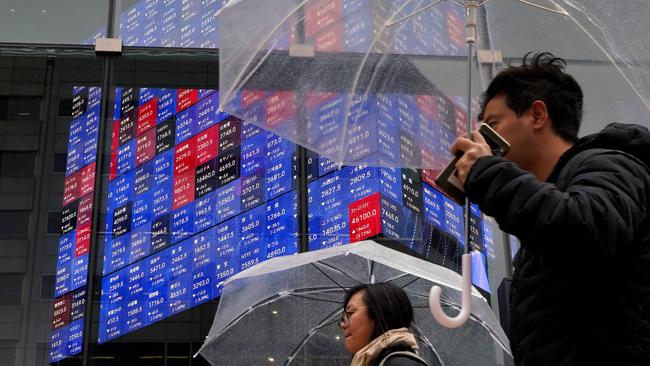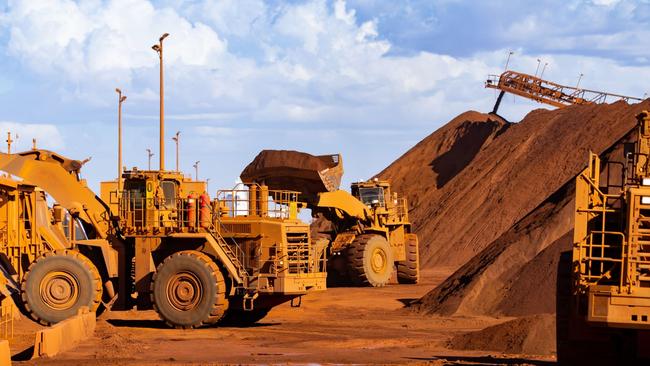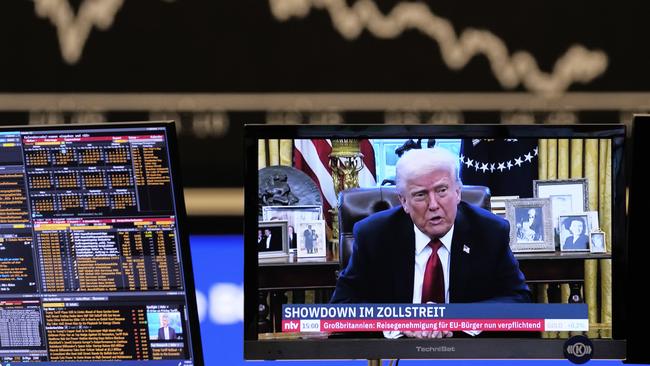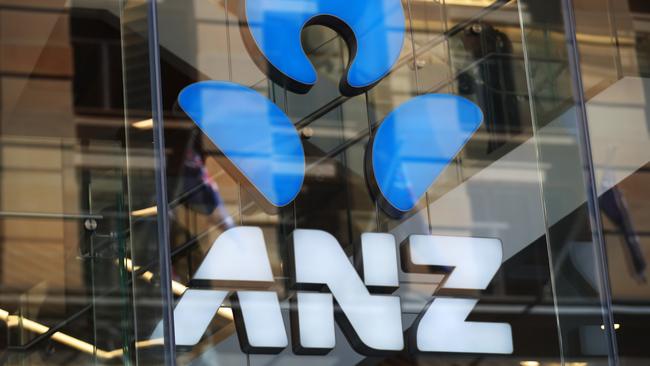
It’s this hit to Asia’s trade flows which will be worse for Australia’s fortunes than the relatively mild 10 per cent “minimum” tariff Trump has slapped on us.
All of Australia’s biggest trading partners have been given higher-than-expected tariffs, and this will be a blow to their respective domestic economies.
Asia represents the centre of the world’s manufacturing supply chain and nearly 60 per cent of the trade takes place within the region; the finished goods ultimately ending up in either the US or Europe.
Japan copped 24 per cent, Korea 25 per cent, India 26 per cent and Vietnam – which is fast rising as the major player in global manufacturing – has been delivered a 46 per cent Trump tariff. China effectively faces combined tariffs of 54 per cent.
Semiconductor giant Taiwan, whose technology will power the AI revolution, was given a 32 per cent tariff by America. Although it appears the finished chips themselves have avoided that.

The iPhone is made in China, Adidas and Nikes are made in Vietnam, while Samsung and LG are made in South Korea, China and increasingly Vietnam. And a dozen car brands are either made or begin life in this region.
As US demand from each of these countries inevitably tails off in the coming year, this represents a major economic blow to the region.
Australia sits at the beginning of this complicated manufacturing chain as a supplier of raw material – from iron ore, copper, energy and increasingly to battery materials.
“Trade flows will shift fundamentally,” one CEO of a globally-connected ASX company told The Australian. “There will be challenges in that.”

Any slowdown in China will be felt directly by Australia. Shares in BHP, Rio Tinto and Fortescue were all down between 2 per cent and 3 per cent on Thursday.
There are other indirect effects. Shares in Australian medical glove manufacturer Ansell, which has factories in Vietnam and Malaysia, are down 14 per cent. The impact on software players like WiseTech Global from slowing trade and even US-listed Atlassian – big suppliers to US companies – are yet to be worked through.
Despite Trump’s promises, the higher prices for US consumers now face for manufactured goods will slice growth there.
Futures markets are pointing to an almost 3 per cent drop in the Wall Street benchmark, the S&P 500, while Nasdaq is off more than 3.3 per cent.
Apple shares were off as much as 7 per cent in after-hours trade and its flagship iPhone now faces double-digit and substantial price rises.
Australian shares ended off 0.9 per cent, having recovered from their intraday lows of as much as 2 per cent. Shares in Europe were down as much as 2 per cent.
Investors were betting the prospect of a global slowdown all but seals the deal for an interest-rate cut from Australia’s Reserve Bank.
Trump hit the EU with a blanket tariff of 20 per cent, making it easier to negotiate a deal as one, rather country by country. Both China and the EU are considering their own retaliatory measures.
China’s domestic economy is already fragile in parts particularly for consumers, and authorities there are eyeing further stimulus measures, cushioning the full impact on Australia. These measures are now almost certain, as Beijing targets growth of about 5 per cent this year.
The big unknown is how much of an opening gambit Trump’s tariffs represent, and to what extent the US President is prepared to pull back on a country-by-country and product-line basis. He’s already cleared copper, energy and semiconductors.
In the recent experience with Canada and Mexico, despite the bluster, he conceded to a swath of carve-outs for other important goods flowing into the US. Although it took weeks to get to this point.
Markets were hoping Liberation Day would offer clarity. Rather, it’s a starting point for more uncertainty to come.
–
ANZ’s risk appetite
For a regulator wanting to make a splash about being tough on cleaning up poor corporate culture, APRA’s decision to use the moment when the world was fixated on the White House is nothing but perplexing.
It’s the equivalent of whistling into a hurricane, and conveniently allowed ANZ to come clean about brewing cultural problems right in the middle of Donald Trump’s tariff blitz.
The timing wouldn’t have made much difference, given ANZ’s outgoing chief, Shayne Elliott, and his bank came off pretty lightly for problems in the Sydney and London trading room that had been allowed to fester for too long.
Worrying warnings to management about issues of bullying, and allegations of drinking and drug abuse by some bond traders, were ignored.
ANZ released the full Oliver Wyman review into the global markets business, which reviewed hundreds of documents and surveyed more than 3400 staff, as well as 110 in-depth interviews.
It said the traders’ alleged behaviour was serious, and in some cases sustained over time.
However, Oliver Wyman found the cases were isolated, and it did not find evidence of systemic misconduct. Overall, the bank’s trading and risk culture was described as positive although it had room for improvement.

It called out management shortcomings around drilling home the importance and ownership of non-financial risk management, including how this relates to staff conduct.
It is worth noting problems were centred in Sydney, London and to a lesser extent Singapore – far away from ANZ’s Melbourne headquarters. As one bank analyst quipped about the Oliver Wyman report – he’s read worse over the years.
Apart from the traders involved in the claims, no one up the chain has lost their job, although Elliott and his markets boss, Mark Whelan, took a hit on bonus payments last year. Elliott finishes up next month and former HSBC banker Nuno Matos takes charge.
Even so, APRA has put ANZ on an even tighter capital leash; it now has to set aside $1bn in additional capital for behaving badly, up from $750m.
To put this in context, at the height of Commonwealth Bank’s Austrac woes it was hit with a $1bn additional capital charge. It will dampen ANZ’s return on equity and potentially delay a return to shareholders, although the bank is already sitting on excess capital.
APRA has demanded an ongoing review of ANZ culture in the coming years.
Elliott has accepted the 19 Oliver Wyman recommendations to improve non-financial risk oversight and has nominated institutional boss Whelan to oversee the program. These will cost in the tens of millions of dollars and take about two years and largely be funds redirected from other compliance programs. In other words, the real earnings hit is net neutral.
Even though there were no direct trading losses for ANZ apart from a very real reputational hit and the loss of lucrative government bond contracts, regulator APRA is right to take its trading floor problems so seriously.
Rogue traders working under poor supervision have the potential to load up extreme risk on to a bank’s balance sheet, and when trades go wrong, the cost could be catastrophic.
It was too late for National Australia Bank in its $360m forex trading scandal two decades ago, while other global banks have fared worse.
Often, trading scandals at banks follow the same template by beginning in the satellite trading floors.
APRA was keen to send a message with the additional capital. It has one eye on its so-called CPS230 standards that come in on July 1. This new set of rules has been years in the making and tightens oversight around operational risk. The rules are designed to specifically tackle non-financial risks, including culture.
ANZ is not out of the woods yet on its trading floor problems.
ASIC is investigating whether there was market manipulation in the case of a $14bn commonwealth government bond program. That is expected to be known in coming months.
eric.johnston@news.com.au




China was always destined to be the target of Donald Trump’s punishing tariffs, however it’s the rest of Asia that has been sent reeling by the trade hit. And this is where the real global financial damage will be done.